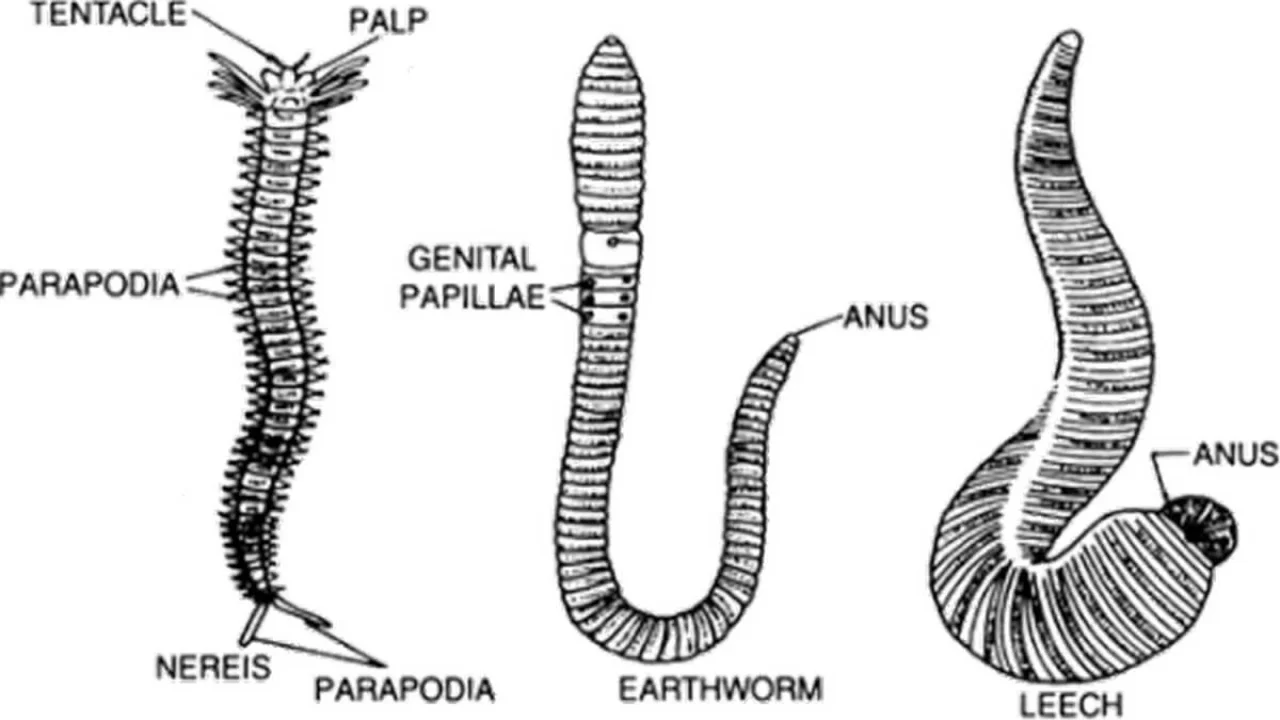
The digestive system of leeches consists of a straight tube called the alimentary canal and associated salivary glands.
Alimentary canal
The alimentary canal of the leech starts with the mouth and ends with the anus. It is divisible into the following parts.
- Fore gut or stomodaeum consisting of the pre-oral chamber, buccal cavity, and pharynx. They are lined with cuticles.
- Mid gut consists of the esophagus, crop, stomach, and intestine. All these have an endodermal lining.
- Hind gut or proctodaeum consists of a rectum lined with a cuticle.

Stomodaeum of foregut
- Pre-oral chamber: The alimentary canal begins with the mouth. The mouth is a small triradiate aperture situated in the center of the anterior sucker. It is guarded by velum made by three lips. The hollow space of the anterior sucker present in front of the mouth is termed a preoral chamber.
- Buccal cavity: The triradiate mouth opens into the buccal cavity. Three crescent jaws are embedded in the mucous membrane of the buccal cavity. One jaw is mid-dorsal in position and the other two are ventrolateral in position. Each jaw is a laterally compressed muscular structure. It is covered with a fine cuticle. It is thickened at the free edges to form a ridge. This ridge shows a row of minute teeth or denticles. Hence the jaw is termed a monostichodont. The median jaw has 103 to 128 teeth, while the lateral jaws bear 85 to 115 teeth on each jaw. On either side of the jaw, 40-45 salivary papillae with many openings of salivary glands are present.
- Pharynx: The next chamber is the pharynx present in the 5th to 7th segment. It is surrounded by salivary glands. The ducts of salivary glands open through the salivary papillae present on jaws.


Midgut or Mesenteron
- Oesophagus: The pharynx opens into a short narrow tube called the esophagus which opens into the crop.
- Crop: It extends from the ninth to the eighteenth segments. It consists of ten segments. It consists of ten chambers, one in each segment. Each chamber is produced into 2 lateral diverticula. The diverticula of the last chamber are the biggest and reach up to the twenty-second segment. The crop acts as a blood storage organ of the leech.
- Stomach: The crop enters into a comparatively small stomach present in the nineteenth- segment. The opening of the crop into the stomach is guarded by a sphincter.
- Intestine: The intestine is a straight & narrow tube. It extends from the 20th segment to the 22nd segment. Its mucous membrane shows longitudinal and transverse folds which increase the absorptive surface. The intestine leads into the rectum.
Hindgut or Proctodaeum
- Rectum: It is broad and a short chamber lying in the 22nd segment to the 26th segment.
- Anus: Rectum opens out through the anus. It is a very small opening present on the dorsal side of the body near the posterior sucker.
Digestive Glands
Leech shows 2 types of digestive glands. 1) Salivary glands, 2) Gland cells in the gut.
- Salivary glands: They are unicellular glands present below the pharynx. Each gland gives a small duct. They open on the salivary papillae of the jaw. The saliva contains a substance called HIRUDIN. It prevents the clotting of the blood of the host during sucking.
- Gland cells in the gut: These are scattered in the epithelium of the crop, stomach, and intestine. They secrete mucous in the cop.
Food of Leech
It sucks the blood of vertebrate animals. structurally leech is a sanguivorous animal.
Feeding
Leech attaches to the host with the posterior sucker. Then it applies the anterior sucker to the host body. The jaws move and make an "A" shaped wound. The blood of the host is then sucked up by pump-like actions of the pharynx. The salivary glands secrete a substance i.e. Hirudin, which prevents coagulation of blood. This enables the leech to draw blood continuously. A leech can suck blood which is 3 to 6 times more than its body weight. This is stored in the crop. When once leech drinks the blood, it need not go for sucking the blood till 3 months to one year.
Digestion
The globin of the blood is the food of the leech. The blood is digested in the stomach. The mechanism is not clear.
- In 1953, Bushing started the digestion by bacteria in the gut.
- Heise (1909) stated that a proteolytic enzyme is present in the gut.
The digested food is absorbed in the stomach and intestine.
The information on this page is peer reviewed by a qualified editorial review board member. Learn more about us and our editorial process.
Last reviewed on .
Article history
- Latest version
Cite this page:
- Comment
- Posted by Dayyal Dungrela